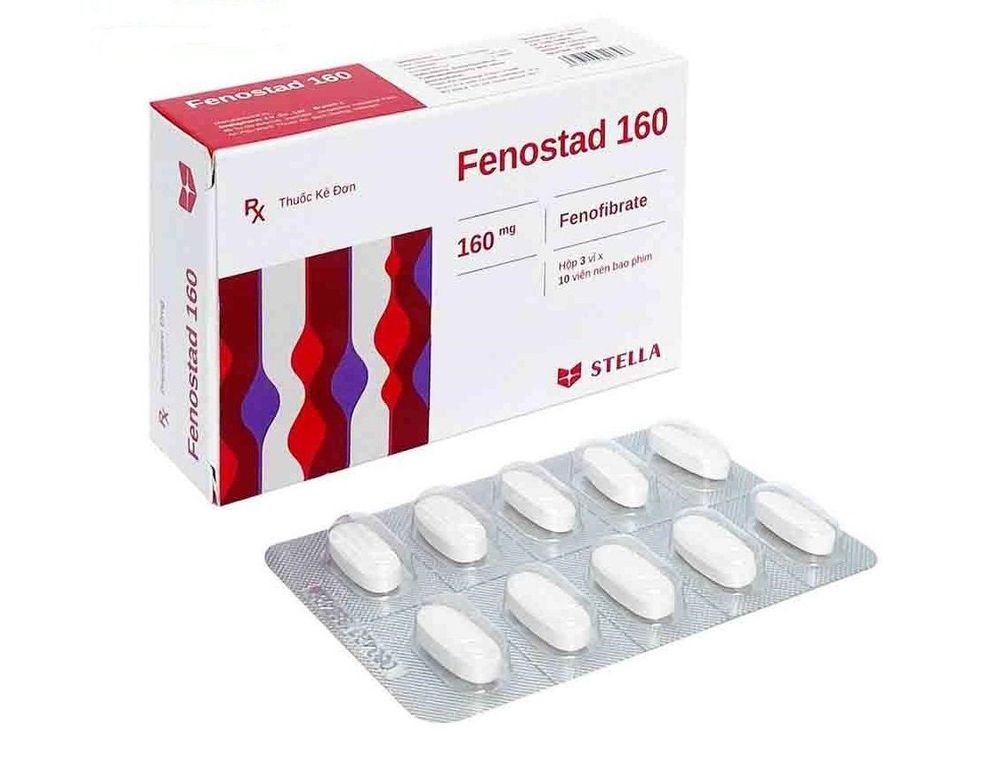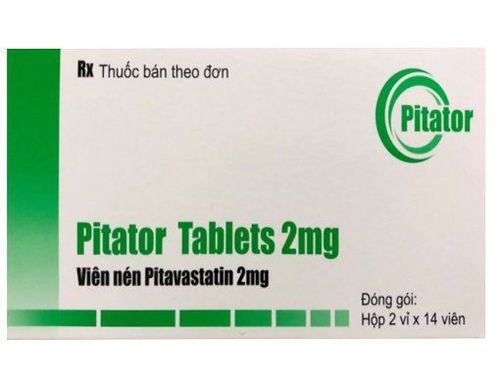This is an automatically translated article.
Fenostad 160mg is usually indicated as an adjunct to diet and other non-drug regimens. Fenostad is used in the treatment of severe hypertriglyceridemia and mixed hyperlipidemia when statin therapy is contraindicated or intolerant. So what is Fenostad 160?
1. What is Fenostad 160?
Fenostad 160 belongs to the group of cardiovascular drugs with the ingredient Fenofibrate 160mg. Fenofibrate, a derivative of fibric acid, is a lipid-lowering drug. The use of Fenostad is to inhibit cholesterol biosynthesis in the liver, thereby reducing components that cause atherosclerosis (very low-density lipoprotein VLDL and low-density lipoprotein LDL). At the same time, the drug increases the production of high-density lipoprotein (HDL) and reduces blood triglycerides. Therefore, Fenostad significantly improves the distribution of cholesterol in the blood plasma. Fenofibrate 160mg is used in the treatment of hyperlipoproteinemia type IIa, type IIb, type III, type IV and type V along with a very lipid-restricted diet. The drug can reduce total cholesterol by 20-25% and blood triglycerides by 40-50%.
2. Indications and contraindications of the drug Fenostad 160mg
Fenostad 160mg is indicated as an adjunct to diet and other non-pharmacological treatment regimens such as exercise and weight loss in the following cases:
Treatment of severe hypertriglyceridemia with or without low HDL cholesterol . Mixed hyperlipidemia when statin therapy is contraindicated or intolerant. Mixed hyperlipidemia in patients at high cardiovascular risk requires the addition of a statin when triglycerides and HDL cholesterol are not adequately controlled. Fenostad 160mg is contraindicated in the following cases:
People with hypersensitivity to fenofibrate or any of its ingredients. Severe renal dysfunction. Liver dysfunction. Acute or chronic pancreatitis, except acute pancreatitis due to severe hypertriglyceridemia. Patients with a history of photo-allergic reactions or phototoxicity during treatment with fibrates or ketoprofen. History of gallbladder disease. Children under 18. Pregnant and lactating women.

Giải đáp Fenostad 160 là thuốc gì?
3. Dosage and how to use Fenostad 160mg
Fenostad 160mg should be taken whole with meals. It is still necessary to continue to maintain the same diet as before treatment. Monitor response to treatment by determining serum lipid indices. If no effect is achieved after several months (such as 3 months), additional or alternative treatments should be considered.
The recommended starting dose for adults is 1 tablet per day taken with a main meal. If you are taking 1 fenofibrate 200mg capsule, you can switch to 1 fenofibrate 160mg tablet without further dose adjustment.
In elderly patients, without renal impairment, Fenostad can be used at the recommended adult dose.
In patients with renal impairment, the dose should be reduced. In patients with severe chronic kidney disease, fenofibrate should not be used. Do not use fenofibrate in patients with liver failure.
The safety and effectiveness of fenofibrate in children and adolescents under 18 years of age have not been established. Therefore, fenofibrate should not be used in children under 18 years of age.
There is no specific antidote for overdose with Fenostad. If overdose is suspected, symptomatic treatment and appropriate supportive measures should be instituted as needed. Hemodialysis is not effective in removing fenofibrate.
4. Possible side effects when using Fenostad 160mg
During the use of Fenostad 160mg, you may encounter the following side effects:
Digestive disorders causing indigestion, nausea, mild diarrhea. Temporarily elevated liver enzymes Skin allergies Muscle pain.

Khó tiêu, tiêu chảy nhẹ là tác dụng phụ có thể gặp khi sử dụng thuốc Fenostad 160mg
5. Precautions when using Fenostad 160mg
The patient's liver and kidney function should be tested prior to treatment with fenofibrate. If, after 3-6 months of treatment, the blood lipids do not decrease, an additional or alternative treatment must be considered. Elevated blood transaminases are usually only temporary. Transaminases should be systematically checked every 3 months for the first 12 months of treatment. Discontinue treatment with Fenostad 160 mg if ASAT and ALAT rise above 3 times the normal limit. If fenofibrate is used in combination with oral anticoagulants, increased monitoring of prothrombin blood levels is required and the anticoagulant dose may need to be adjusted accordingly during fenofibrate therapy and 8 days after discontinuation. treatment with this drug. Bile complications are likely to occur when using Fenostad 160mg in people with cholestatic cirrhosis or gallstones. Blood counts should be regularly checked during treatment with Fenostad 160mg. Fenostad is used in the treatment of severe hypertriglyceridemia and mixed hyperlipidemia when statin therapy is contraindicated or intolerant. To ensure the effectiveness of treatment and avoid side effects, patients need to take medicine according to prescription or consult a doctor, pharmacist for advice.
Follow Vinmec International General Hospital website to get more health, nutrition and beauty information to protect the health of yourself and your loved ones in your family.
Please dial HOTLINE for more information or register for an appointment HERE. Download MyVinmec app to make appointments faster and to manage your bookings easily.













